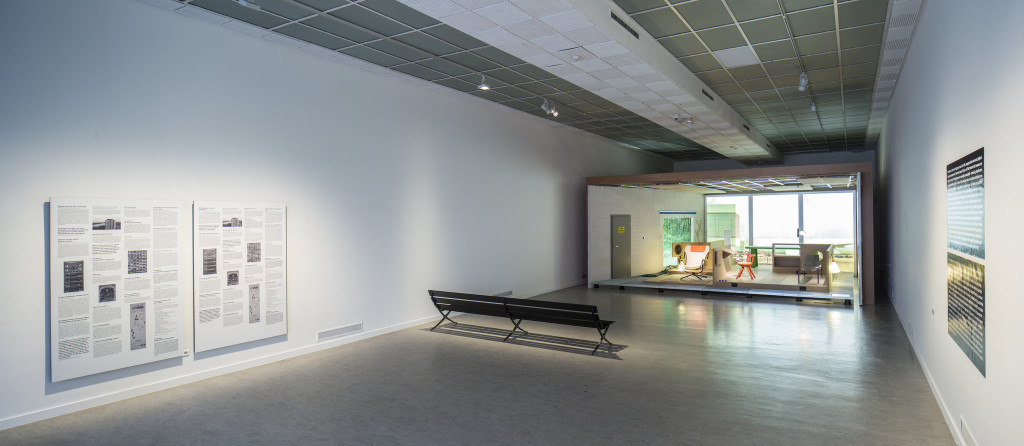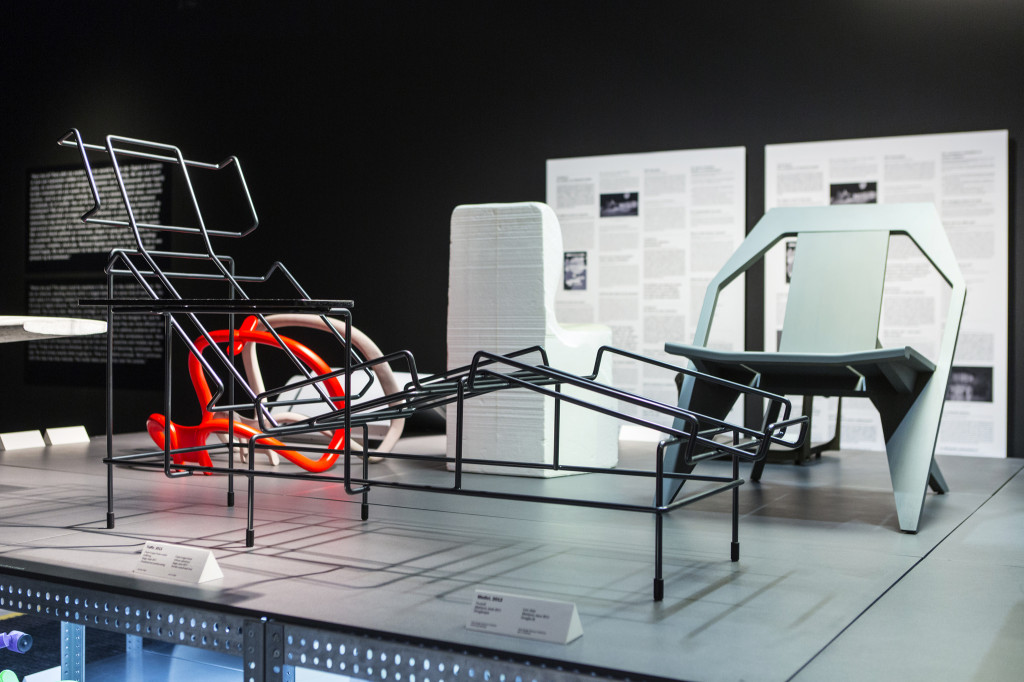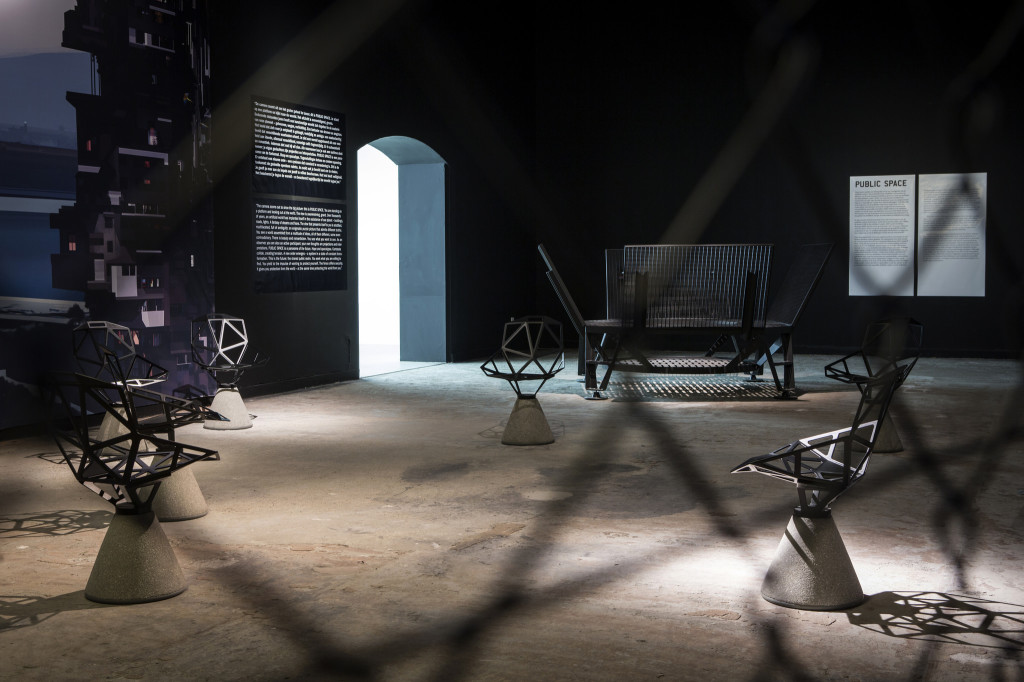Konstantin Grcic – Panorama
On Future Living, Working and Public Space
‘Konstantin Grcic – Panorama’ is the largest solo exhibition on one of the most influential designers of our time. ‘Panorama’ is not a mere retrospective exhibition, but rather a personal statement by Konstantin Grcic on the future.

Konstantin Grcic has developed three large scale installations rendering his personal visions for life in the future specifically for this exhibition: a home interior, a design studio and an urban environment. These spaces stage fictional scenarios confronting the viewer with the designer’s inspirations, challenges and questions, as well as placing Grcic’s works in a greater social context. The highlight of these presentations is a 30-metre long panorama that depicts an architectural landscape of the future. A fourth area in the exhibition shows Grcic’s designs, prototypes and drawings along with designs, artefacts and found objects, that have inspired Grcic.
These spaces stage fictional scenarios confronting the viewer with the designer’s inspirations, challenges and questions, as well as placing Grcic’s works in a greater social context. Extensive research into multiple questions for the near future on how our private and public spaces will evolve was made for each of the spaces. This information – pieces of news articles, opinions, questions, statistics, design or architectural proposals linked to topics was collected to research pages pieces, and are addressed in Grcic’s speculative installations.
With ‘Panorama,’ Grcic enters new territory. Never before has he so fundamentally reflected on his own work and so thoroughly disclosed his own understanding of design in general. The exhibition is based on an extensive analysis of current technological shifts, innovations and upheavals in contemporary design. It was developed over three years of close collaboration between Grcic, Vitra Design Museum and Z33. The result is a striking presentation of narrative and visual intensity, situated on the cusp between present and future, reality and fiction.

Life Space
Every home is a reflection of its dwellers, but how we live is also a mirror of the times. The evidence of memories, personal possessions and established conventions is found in our private interiors. Yet a home is equally a vision of the future: what kind of environment do we want to call our own? Is being constantly available and keeping up appearances important? Or would we rather withdraw from the world and curl up in cosy seclusion?
Over the course of his career, Konstantin Grcic has created numerous objects that bring fresh forms into living. Grcic has used these and other objects to create ‘Life Space,’ an interior that reflects his personal conception of a living room of the future. To “stage” his vision, Grcic designed the module ‘Life Stage’ especially for this exhibition. The module is made of the novel composite Acrodur® and not only houses technical components for heating, electricity and stereo equipment, but can be assembled in a variety of configurations. In her video installation Time Frames, film director Mia Grau explores possible manifestations of everyday life in this space.
Grcic seeks a balance between intimacy and technology. He presents solutions for practical needs such as physical comfort, power access and domestic functions, which consequently serve as a foundation to evolve an aesthetic of the home – a collage of old and new, of known and unknown, complete with the empty spaces and gaps which are present in every interior. With his ‘Life Space,’ Grcic advocates a heightened understanding of the interior as a reflection of personal identity: the identity of people living in the twenty-first century.

Work Space
Our work life and culture is experiencing a major transformation. Working and living spaces are merging, work processes have become digitized or are outsourced, and new technologies have replaced age-old production methods. Designers, too, are affected by these changes. In his setting ‘Work Space,’ Konstantin Grcic portrays the everyday reality of his own work environment and presents ideas on what it might look like in the future.
This part of the exhibition shows how so-called new technologies have already become familiar tools for designers: objects are designed with software programs, models are produced using 3D printers or laser cutters, data is shared via online platforms, and blogs and chat forums are used for conducting research. And yet, Grcic also continues to work with tangible methods: 1:1 models, material samples and books, and a practiced manufacturer’s know-how which is continually applied to new situations.
It is unclear whether Grcic’s ‘Work Space’ is a research lab, a data bunker or a classic workshop. This ambiguity reflects the conditions designers are faced with today: new technologies bring extraordinary opportunities but also raise questions concerning data privacy and copyright – or even the true source of creativity. In ‘Work Space,’ these questions become the actual object of debate: how can we employ these technologies so that they serve the people who use them, including designers – and not the other way around? How much creativity can be transferred to virtual spaces? What new forms will our objects take in the digital age?

Public Space
Designers play a major role in creating public spaces. From advertisements and furniture for parks and plazas to diverse means of transportation, designers shape public and semi-public zones. Whether in train stations, airports, restaurants or cafés, these are places in which we – equipped with laptop and smart phone – spend increasing amounts of time. At the same time, the future of public space is currently a subject of heated debate. How can we ensure that growing urbanization is given a humane form? Do public spaces belong to the state, to corporations or to the individual citizen? How can we ally disparate needs regarding mobility, energy generation, quality of life and environmental protection?
Over the course of his career, Konstantin Grcic has also created objects for outdoor spaces. At first sight, many of Grcic’s objects are unwieldy and strange, impressing themselves upon our minds as singular sculptures. They were designed to set accents in the spaces they occupy and to initiate a communicative exchange with the observer.
For the exhibition, Grcic has transferred several of these objects into a fictive public space. In this part of the exhibition, Grcic’s furniture is accessible for the use of visitors – inviting us to become active participants in a public space of the future.

Object Space
In the wake of the fundamental questions addressed in the first three areas of the exhibition, this space shows the essence of Grcic’s daily work: a concentrated approach to creating new objects. On display is a multitude of products, drawings, prototypes and other pieces from Konstantin Grcic’s creative oeuvre. These are supplemented by objects that serve Grcic as a source of inspiration: the work of respected designers, books, found objects and everyday items. Grcic has accumulated these artefacts over a period of many years, referring to them as his “archive of things”. They are of crucial importance to his daily work: as tools, as inspirational catalysts and as a physical memory bank.
At the outset of most projects there is a client request in connection with a main theme, followed by its subsequent development in a step-by-step process. Grcic progresses experimentally through all possible variations with regard to form, construction, materials and production methods, which can often lead to surprises and unexpected solutions. Yet Grcic’s objects are also part of a larger whole, for many of them take shape simultaneously, influencing each other and generating connections and friction – which then serve as inspiration for further projects. This, too, is a process in which chance and spontaneous association are as important as precision and methodical decisions.
To visualize these processes, the items in this space are arranged like a model of evolutionary development.
‘Konstantin Grcic – Panorama’ is an exhibition of Vitra Design Museum and Z33 – House for Contemporary Art.
Film
Opening talk ‘Konstantin Grcic – Panorama’ at Vitra Design Museum, Weil am Rhein, Germany, on 21 March 2014.
Konstantin Grcic talks about his work with Mateo Kries, director of Vitra Design Museum, and Jan Boelen, artistic director of Z33 – House of contemporary art – inspiration and innovation, challenges of contemporary design and social and technological utopias that could shape the world of tomorrow.
Duration 01:05:20, in English.
Watch video